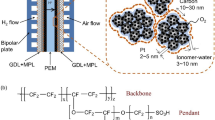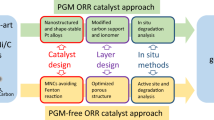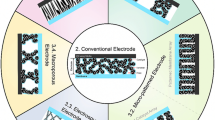Abstract
Electro catalyst Pt–Co/multi-walled C nanotubes were synthesized by using the modified polyol method with glycol as reducer. The magnetic-field-assisted fabrication of membrane electrode assemblies (MEAs) for proton exchange membrane fuel cells (PEMFCs) was proposed, to orient catalyst layers and increase the efficiency of catalyst utilization. PEMFCs with the magnetic-field-treated MEA (M-MEA) exhibited significant performance improvement over common MEA (C-MEA) without magnetic-field treatment. Under the same operating conditions, the maximum power density of MEA increased from 149.6 to 223.8 mW cm−2 when C-MEA was replaced by M-MEA. Scanning electron microscope images showed that catalysts exhibited a “cluster-like structure” in M-MEA opposed to a chaotic arrangement in C-MEA. Electrochemical impedance spectroscopy measurements revealed that M-MEA reaction resistance was lower than that of C-MEA. Cyclic voltammetry data showed an increment of almost 29.6 % in electrochemical surface area as a result of the magnetic-field treatment.








Similar content being viewed by others
References
Haile SM (2003) Fuel cell materials and components. Acta Mater 51:5981
Schultz T, Sundmacher K (2006) Mass charge and energy transport phenomena in a polymer electrolyte membrane (PEM) used in a direct methanol fuel cell (DMFC): modelling and experimental validation of fluxes. J Membr Sci 276:272
Yan Xiqiang, Hou Ming, Sun Liyan, Cheng Haibo, Hong Youlu, Liang Dong, Shen Qiang, Ming Pingwen, Yi Baolian (2007) The study on transient characteristic of proton exchange membrane fuel cell stack during dynamic loading. J Power Sour 163:966
Antolini E, Salgado JRC, Giz MJ, Gonzalez ER (2005) Effects of geometric and electronic factors on ORR activity of carbon supported Pt–Co electrocatalysts in PEM fuel cells. Int J Hydrogen Energy 30:1213
Cho YH, Jeon TY, Lim JW, Cho YH, Ahnb M, Jung N (2011) Performance and stability characteristics of MEAs with carbon-supported Pt and Pt1Ni1 nanoparticles as cathode catalysts in PEM fuel cell. Int J Hydrogen Energy 36:4394
Rao CS, Singh DM, Sekhar R, Rangarajan J (2011) Pt–Co electrocatalyst with varying atomic percentage of transition metal. Int J Hydrogen Energy 36:14805
Fox EB, Colon-Mercado HR (2010) Effect of pretreatment on Pt–Co/C cathode catalysts for the oxygen reduction reaction. Int J Hydrogen Energy 35:3280
Paulus UA, Wokaun A, Scherer GG, Schmidt TG, Stamenkovi V, Radmilovic V (2002) Oxygen reduction on carbon-supported Pt–Ni and Pt–Co alloy catalyst. J Phys Chem B 106:418
Mukerjee S, Srinivasan S, Soriaga MP, McBreen J (1995) Role of structural and electronic properties of Pt and Pt alloys on electrocatalysis of oxygen reduction. J Electrochem Soc 142:1409
Seo A, Lee J, Han K, Kim H (2006) Performance and stability of Pt based ternary alloy catalysts for PEMFC. Electrochim Acta 52:1603
Baglio V, Blasi AD, D’Urso C, Antonucci V, Arico AS, Ornelas R (2008) Development of Pt and Pt–Fe catalysts supported on multi-walled carbon nanotubes for oxygen reduction in direct methanol fuel cells. J Electrochem Soc 155:829
Shujuan J, Yanwen M, Guoqiang J, Haisheng T, Xizhang W, Yining F (2009) Facile construction of Pt–Co/CNT nanotube electrocatalysts and their application to the oxygen reduction reaction. Adv Mater 21:4953
Oren Y, Freger V, Linder C (2004) Highly conductive ordered heterogeneous ion-exchange membranes. J Membr Sci 239:17
Hsiu-Li Lin T, Leon Yu, Han Fang-Hsin (2006) A method for improving ionic conductivity of Nafion membranes and its application to PEMFC. J Polym Res 13:379
Schwarz MK, Bauhofer W, Schulte K (2002) Alternating electric field induced agglomeration of carbon black filled resins. Polymer 43:3079
Wang HQ, Zhang HY, Zhao WF, Zhang W, Chen GH (2008) Preparation of polymer/oriented graphite nanosheet composite by electric field-inducement. Compos Sci Technol 68:238
Wang Z-T, Wang Y-X, Xua L, Gao Q-J, Wei G-Q, Lua J (2009) Electric field-treated MEAs for improved fuel cell performance. J Power Sources 186:293
Middelman E (2002) Improved PEM fuel cell electrodes by controlled self-assembly. Fuel Cells Bull 2002:9
Yonermura H, Natsuko S, Suyama J, Yamada S (2011) Orientation and organization of gold nanorods on a substrate using a strong magnetic field: effect of aspect ratio. J Photochem Photobio A 220:179
Hasanabadi N, Ghaffarian SR, Hasani-Sadrabadi MM (2011) Magnetic field aligned nanocomposite proton exchange membranes based on sulfonated poly (ether sulfone) and Fe2O3 nanoparticles for direct methanol fuel cell application. Int J Hydrogen Energy 36:15323
Wang J, Scampicchio M, Laocharoensuk R, Valentini F, González-Garcia O, Burdick J (2006) Magnetic tuning of the electrochemical reactivity through controlled surface orientation of catalytic nanowires. J Am Chem Soc 128:4523
Xiong LF, Manthiram A (2004) Influence of atomic ordering on the electrocatalytic activity of Pt–Co alloys in alkaline electrolyte and proton exchange membrane fuel cells. J Mater Chem 14:1454
Huang QH, Yang H, Tang YW, Lu TH, Akins DL (2006) Carbon supported Pt–Co alloy nanoparticles for oxygen reduction reaction. Electrochem Commun 8:1220
Zengcai L, Chengfei Y, Irene A, Rusakova E, Huang D, Peter S (2008) Synthesis of Pt3Co alloy nanocatalyst via reverse micelle for oxygen reduction reaction in PEMFCs. Top Catal 49:241
Lu L, Xu H, Zhao H, Zhu S, Ren R (2012) Investigation of the durability of Pt/C-RuO2·xH2O catalyst in PEMFC. J Appl Electrochem 42:201
Acknowledgments
This research was funded by the National Basic Research Program of China (973 Program, Grant No. 2012CB215500) and the National Natural Science Foundation of China (No. 21106012).
Author information
Authors and Affiliations
Corresponding author
Rights and permissions
About this article
Cite this article
Sun, X., Xu, H., Lu, L. et al. Preparing a catalyst layer in magnetic field to improve the performance of proton exchange membrane fuel cells. J Appl Electrochem 44, 1179–1184 (2014). https://doi.org/10.1007/s10800-014-0734-7
Received:
Accepted:
Published:
Issue Date:
DOI: https://doi.org/10.1007/s10800-014-0734-7




